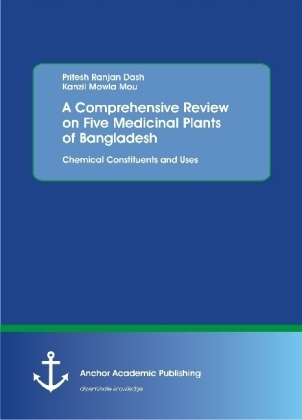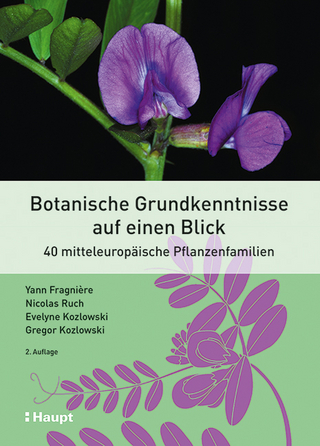
A Comprehensive Review on Five Medicinal Plants of Bangladesh. Chemical Constituents and Uses
Anchor Academic Publishing (Verlag)
978-3-96067-117-6 (ISBN)
Pritesh Ranjan Dash, R. Ph, has earned a Bachelor's and Master's Degree in Pharmacy from Stamford University, Bangladesh, in 2010 and 2012 as well as a M. Phil Part-1 in Pharmacy from Jahangirnagar University in 2015. Currently, he is attending a PhD in Pharmacy at Jahangirnagar University, Bangladesh, and teaches at the Pharmacy Department at BRAC University, Mohakhali, Dhaka. He has already published one book and more than 17 research articles on medicinal plants in reputed national and international journals.
Text Sample:
Chapter 4 Pharmacological Activities of Five Medicinal Plants:
Pharmacological Activities of Gymnema sylvestre:
Anti-diabetic Activity: The hypoglycemic action of Gymnema sylvestre leaves was first documented in the late 1920s. The plants hypoglycemic action is gradual in nature, differing from the rapid effect of many prescription hypoglycemic drugs. Gymnema leaves raise insulin levels by causing regeneration of Beta cells in the pancreas that secrete insulin. Research has shown that Gymnema improves the uptake of glucose into cells by increasing the activity of glucose-metabolizing enzymes, and preventing adrenaline from stimulating the liver to produce glucose, with the net effect that blood sugar levels are reduced. Another antidiabetic effect of Gymnema is that it negates the taste of sugar, which has the effect of suppressing and neutralizing the craving for sweets. Gymnemic acid found in the leaf extracts inhibits hyperglycemia and also acts as a cardiovascular stimulant.
Oral administration of a water soluble fraction G-54 isolated from Gymnema sylvestre administered to 27 type 2 diabetic patients reduced their insulin requirement, lowered the fasting blood sugar and glycosylated haemoglobin content (Shanmugasundaram et al., 1990a). Two water soluble fractions (GS-3 and GS-4) obtained from leaves were found to double the pancreatic islets and ß-cell numbers in diabetic rats (Shanmugasundaram et al., 1990b).Alcoholic leaf extract (500mg/kg, orally) lowered maximum blood sugar in fasted, glucose fed and diabetic rats along with insulin released from pancreatic ß-cells (Chatopadhyay et al., 1993). In rats the insulin secretion from islets of Langerhans and several pancreatic ß-cell lines induced by alcoholic extract in absence of other stimulus (Persaud et al., 1999). Gymnemic acid IV, isolated from leaves produced potent hypoglycemic effect in STZ-diabetic mice (Sugihara et al., 2000). Leaf extract has been observed to produce anti-hyperglycemic (Gholap et al., 2003) and hypoglycemic (Gholap et al., 2004) effects of in corticosteroid-induced diabetes mellitus, without altered serum cortisol concentration. A polyherbal formulation containing aqueous extracts of Gymnema sylvestre produced prominent hypoglycemic activity in normal and diabetic rats at a dose of 100- 500mg/kg/day, orally for acute, 6 hours and for long-term, 6 weeks studies (Mutalik et al., 2005). Gymnemic acid IV isolated from the leaves has been observed to produce hypoglycemic, anti-hyperglycemic, glucose uptake inhibitory and gut glycosidase inhibitory effects (Kimura, 2006). G. sylvestre leaves extract also treated diabetic rats' complications including hyperglycemia, hypoinsulinemia, hyperlipidemia and oxidative stress (Aziza et al., 2013).
Hypolipidemic Activity: Gymnema leaves are also noted for lowering serum cholesterol and triglycerides. Gymnema leaf extract at a dosage of 25-100 mg/kg administered orally to experimentally induced hyperlipidemic rats for two weeks reduced the elevated serum trigylceride, total cholesterol, very low density lipoprotein and low density lipoproteincholesterol in a dose-dependent manner. The ability of the extract at 100mg/kg to lower triglycerides and total cholesterol in serum and ist anti-antheroscelrotic potential was similar to that of the standard lipid-lowering agent Clifibrate. (Bishayee and Chatterjee, 1994).
Antiobesity Study: G. Sylvestre helps to promote weight loss possibly through ist ability to reduce cravings for sweets and control blood sugar levels. It has been reported that the gurmarin peptide block the ability to taste sweet or bitter flavors and thus reduces sweet cravings (Ninomiya et al., 1995). A standardized G. sylvestre extract in combination with niacin-bound chromium and hydroxycitric acid has been evaluated for antiobesity activity by monitoring changes in body weight, body mass index (BMI), appetite, lipid profiles, serum leptin and excretion of urinary fat metaboli
| Erscheinungsdatum | 20.03.2017 |
|---|---|
| Sprache | englisch |
| Maße | 155 x 220 mm |
| Gewicht | 122 g |
| Themenwelt | Naturwissenschaften ► Biologie ► Botanik |
| Naturwissenschaften ► Chemie ► Organische Chemie | |
| Schlagworte | Coccinia cordifolia • Gymnema sylvestre • Lagerstroemia speciosa • Momordica charantia • Pharmacological activities • Pharmacological activity • Phytoconstituents • Toxicity • Trigonella foenum-graecum |
| ISBN-10 | 3-96067-117-2 / 3960671172 |
| ISBN-13 | 978-3-96067-117-6 / 9783960671176 |
| Zustand | Neuware |
| Haben Sie eine Frage zum Produkt? |
aus dem Bereich


